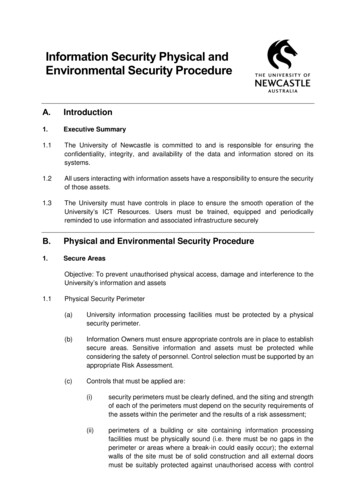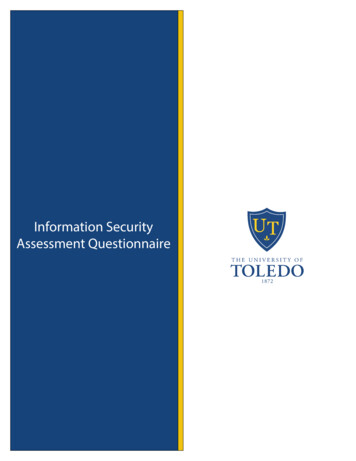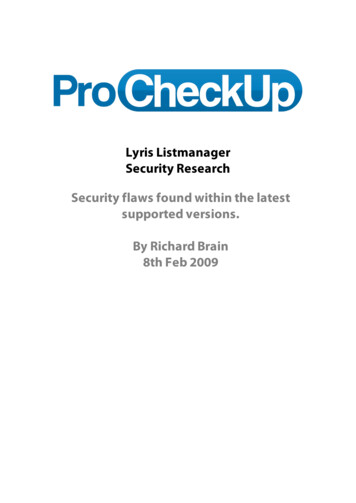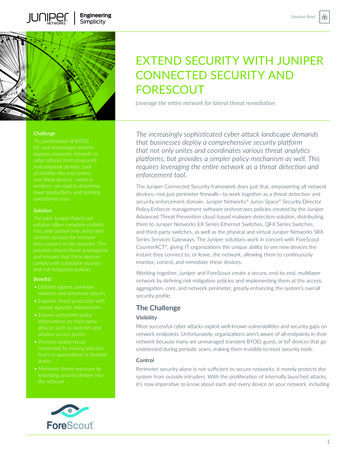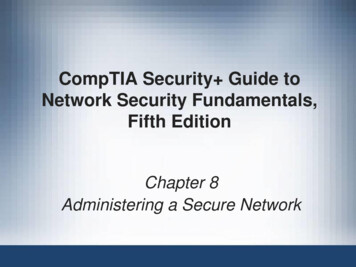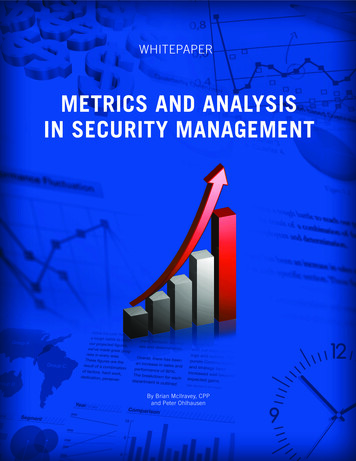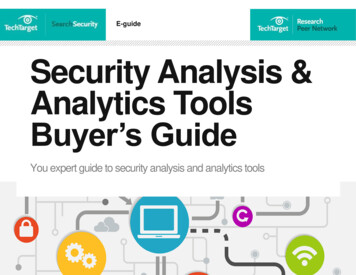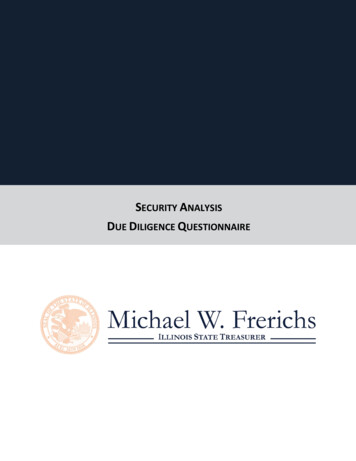
Transcription
SECURITY ANALYSISDUE DILIGENCE QUESTIONNAIRE
Table of ContentsInvestment Philosophy. iFrequently Asked Questions . iiAnalysis Questions. 1Quantitative and Qualitative Data to Consider . 3Security Analysis Questionnaire – May 2020
Investment PhilosophyThe PUBLIC FUND seeks to invest all funds under its control in a manner that provides the highest riskadjusted investment return for beneficiaries using authorized instruments. To achieve this objective, thePUBLIC FUND has a responsibility to recognize and evaluate risk and opportunity factors that may have amaterial and relevant financial impact on the safety and/or performance of our investments. In addition to theconsiderations and objectives as set forth in the Investment Policy Statement, the PUBLIC FUND complieswith all Illinois state laws and regulations including the Illinois Sustainable Investing Act (30 ILCS 238/1 et seq.)Thus, consistent with achieving the investment objectives set forth herein, the PUBLIC FUND and its agentsshall prudently integrate sustainability factors into its investment decision-making, investment analysis,portfolio construction, due diligence and investment ownership in furtherance of the PUBLIC FUND’Sinvestment goals to fulfill its fiduciary duty, to maximize anticipated financial returns, and minimize projectedrisk.Sustainability factors shall be implemented within a framework predicated on the prudent integration of materialsustainability factors, including, but not limited to (1) environmental, (2) social capital, (3) human capital, (4)business model and innovation, and (5) leadership and governance factors, as components of portfolioconstruction, investment decision-making, investment analysis and due diligence, prospective valueproposition, risk management, and investment ownership, given that these tangible and intangible factors mayhave material and relevant financial impacts. Other relevant factors such as legal, regulatory, and reputationalrisks that contribute to an optimal risk management framework and are necessary to create long-terminvestment value should also be considered.The sustainability analysis adds an additional layer of rigor to the fundamental analytical approach and can beused to evaluate past performance and be used for future planning and decision-making. Similar to financialaccounting, sustainability accounting has both confirmatory and predictive value, thus, it can be used toevaluate past performance and be used for future planning and decision-making. As a complement to financialaccounting, it provides a more complete view of an investment fund or portfolio company’s performance onmaterial factors likely to impact its long-term value.iSecurity Analysis Questionnaire – May 2020
Frequently Asked Questions1. What is the purpose of this document?The goal of the PUBLIC FUND is to assess a framework predicated on the prudent integration of materialsustainability factors, including, but not limited to (1) environmental, (2) social capital, (3) human capital,(4) business model and innovation, and (5) leadership and governance factors, as components of portfolioconstruction, investment decision-making, investment analysis and due diligence, prospective valueproposition, risk management, and investment ownership, given that these tangible and intangible factorsmay have material and relevant financial impacts. The sustainability analysis adds an additional layer ofrigor to the fundamental analytical approach and can be used to evaluate past performance and be usedfor future planning and decision-making.The PUBLIC FUND complies with all Illinois state laws and regulations including the Illinois SustainableInvesting Act (30 ILCS 238/1 et seq2. Who should use this document?An analyst from the PUBLIC FUND seeking to integrate sustainability factors into the financial analysis ofa Public Company. Sustainability factors are just one of many factors when assessing the risk profile andvaluation of an investment security. The factors complement traditional financial analyses to better identifyinvestment risks and opportunities. The document provides a general outline of factors to consider basedon the impact of industry-specific topics for the Public Company.3. Are Public Companies expected to disclose information considered material to the reasonableinvestor?Materiality is a fundamental principle of financial reporting in the United States. Federal regulationprescribed under the Securities Act requires U.S. publicly listed companies to provide investors and otherusers with material information that is necessary to form an understanding of the company’s financialcondition and operating performance, as well as its prospects for the future. Per the U.S. Supreme Court,information is material “if there is a substantial likelihood that the omitted fact would have significantlyaltered the total mix of information available to the reasonable investor.”4. How should Public Companies report on sustainability factors?As mentioned in the previous question, Public Companies should disclose information that may bematerial to the reasonable investor. Regulation S-K provides the reporting structure for Public Companiesthat is relevant to the disclosure of sustainability information. In the Management’s Discussion and Analysisof Financial Condition and Results of Operations (MD&A) Public Companies are required to disclose anyknown trends, events, risks or uncertainties that can impact the performance of the Public Company. If theinformation is not available in regulatory filings, the Public Company may disclose in sustainability relatedreports prepared and available for stakeholders. Disclosure of sustainability topics should be reasonablylikely to have a material impact on the financial condition or operating performance of the company. Theinformation reported should be decision-useful to the reasonable investor. The sustainability reportingshould be cost-effective for the Public Company to implement. The data should be industry-specific toenable the PUBLIC FUND to make better informed decisions on the management of the portfolio.5. Should the PUBLIC FUND only use this document for the sustainability valuation of a PublicCompany?No. This document should supplement the financial review of a Public Company and serve as a generaltemplate to help identify issues and topics relevant and material to the PUBLIC FUND’S investmentdecision-making process. This document should serve as a reference to understand what type ofsustainability related questions to ask and topics to consider when reviewing a Public Company. Whilethe PUBLIC FUND believes that this is a comprehensive document which covers the central questionsiiSecurity Analysis Questionnaire – May 2020
institutional investors should consider pertaining to the incorporation of sustainability factors, it may benecessary to supplement this document with additional questions.6. Are there additional resources/information to assist the PUBLIC FUND in learning more aboutsustainability integration?Yes. Due to investor demand, Public Companies are beginning to provide more sustainability relatedinformation that is material, reliable, comparable, decision useful and industry-specific. Below are severallocations to find additional information. Public Company reports such as: Audited 10-Ks, Sustainability Reports, Environmental Reportsand Corporate Social Responsibility Reports;SASB Materiality Map: Identifies sustainability issues that are likely to affect the financialcondition or operation performance of companies within an industry;SASB Engagement Guide: Facilitates more focused, meaningful discussion between investorsand Public Companies about financially material sustainability risks and opportunities;Carbon Disclosure Project: A not-for-profit charity that runs the global disclosure system forinvestors, companies, cities, states and regions to manage their environmental impacts; andThe United Nations-supported Principles for Responsible Investment provides resources,including A Guide to ESG Integration for Equity Investing and An Introduction to ResponsibleInvestment: Fixed Income.Third-Party sustainability data providers (e.g. Sustainalytics, ISS, MSCI, etc.).
Analysis QuestionsThe questions below apply to a Public Company with an exposure that may result in impacts to the company’sfinancial condition or operating performance. A Public Company may have exposure to one, multiple, or all thesections. The analyst from the PUBLIC FUND must identify the industry which the Public Company operatesand whether the topics are likely to be material.1. EnvironmentThis section provides environmental impacts, either using nonrenewable, natural resources as inputs tothe factors of production or through harmful releases into the environment. Answers should be evaluatedagainst historical trends, industry peers, and other third-party ratings.1.1. How is the company managing energy consumption and related price and supply risks?1.2. What strategies are in place to increase energy efficiency and manage the company's energymix?1.3. How is the company increasing water efficiency and managing water use?1.4. What is the company's strategy for managing the environmental and biodiversity impacts of itsoperations?1.5. What is the company's exposure to emissions-limiting regulations? How does the geography ofthe company's operations factor into this analysis?1.6. What are the potential costs, risks, and opportunities associated with achieving renewableenergy targets?2. Social CapitalThis section relates to the expectation that a business will contribute to society in return for a social licenseto operate. Answers should be evaluated against historical trends, industry peers, and other third-partyratings.2.1. What are the company's policies related to the collection, use, and retention of customer dataand how does it minimize legal or reputational risks?2.2. How does the company identify and address vulnerabilities and threats as well as prevent datasecurity breaches?2.3. What safety issues or regulations present the most significant risks and opportunities?2.4. What is the company's process for managing risks and opportunities associated with its relationswith the community in which it operates?2.5. How does the company ensure that communication to customers about its products and servicesis clear and transparent?3. Human CapitalThis section addresses the management of a company’s human and workforce resources as key assetsto delivering long-term value. Answers should be evaluated against historical trends, industry peers, andother third-party ratings.3.1. What is the company's strategy to engage employees and reduce turnover?3.2. What actions does the company take to ensure gender and racial/ethnic diversity throughout theorganization, particularly in management, professional and technical roles? How does this varyby geographic region?3.3. How has the company performed in addressing employee health and safety, and how does itpromote a strong safety culture?3.4. How does the company assess, monitor, and reduce exposure to health and safety risks in itsworkforce?1Security Analysis Questionnaire – May 2020
3.5. What is the company's strategy to ensure compliance with labor and employment discriminationlaws?4. Business Model & InnovationThis section addresses the integration of environmental, human and social issues in a company’s valuecreation process. Answers should be evaluated against historical trends, industry peers, and other thirdparty ratings.4.1. How is the company positioning itself to capture the growing market for sustainable products?4.2. How do the company's policies promote the adoption of energy efficient and low carbontechnology?4.3. What actions are the company taking to increase transparency into environmental impacts in itssupply chain? What is the company's progress?4.4. What is the company's approach to the incorporation of environmental, social and governance(ESG) factors into its investment analysis, strategies and decision-making process?4.5. What is the company's credit exposure to different industries and what is the company's exposureto sustainability-related risks and opportunities?5. Leadership and GovernanceThis section involves the management of issues that are inherent to the business model or commonpractice in the industry.5.1. What are the company's strategies for preventing corruption and bribery? Does this strategy differfor areas with a relatively high risk of corruption or bribery?5.2. How has the company performed on preventing fraud, insider trading, anti-trust, anti-competitivebehavior, market manipulation, malpractice, or other illegal activities?5.3. How does the company engage in the legal and regulatory process regarding policy proposalsthat address environmental and social factors affecting the industry?5.4. How is the company positioned to meet regulatory requirements and respond to changes inregulation? How does this vary geographically?5.5. What systems does the company have in place to manage safety risks and ensure a strong safetyculture, including emergency preparedness?6. Corporate GovernanceThis section covers the essential component of responsible investment stewardship and risk managementby supporting good governance practices.6.1. Is the Board balanced by skills and experience to provide appropriate oversight of the company’smanagement?6.2. What is the diversity background of the Board? Does the company have women serving on theBoard? Does it have a diversity policy?6.3. How does the company’s remuneration plan incentivize Board member performance? What isthe industry best practice?6.4. Does your firm have an independent board chair? If no, why not?6.5. Does the company haveexecutive compensation?a sustainability or ESG committee? Is ESG performance tied to2Security Analysis Questionnaire – May 2020
Quantitative and Qualitative Data to ConsiderQuantitative data can be used for fundamental and comparative analysis to track the performance of aPublic Company over the years and to measure against the industry competitors. Qualitative data is usedto identify the Public Company’s description of approach to identifying risks and opportunities. Answersshould be evaluated against historical trends, industry peers, and other third-party ratings. GHG Scope 1 Intensity per Sales GHG Intensity per EBITDA Water Intensity per Sales Water Use/Withdrawal Intensity per Sales Energy Use per Revenue Waste Recycled to Total Waste Change in Facilities Audited YoY Contingencies to Total Assets Litigation Expenses to Total Expenses R&D Expenses per Cashflow Total Recordable Incident Rate Lost Time Incident Rate Employee Turnover % Number of Data Breaches Other Commercial Loans to Total Loans Community Spending % of Women in the Workforce % of Women on the Board Women in Management to Total Employee Ratio % of Employees Represented by Gender, Racial/Ethnic Groups Business Ethics Policy Consumer Protection Policy Employee Protection/Whistle Blower Policy Anti-Bribery Ethics Policy Quality Assurance and Recall Policy3Security Analysis Questionnaire – May 2020
Security Analysis Questionnaire – May 2020 3.5. What is the company's strategy to ensure compliance with labor and employment discrimination laws? 4. Business Model & Innovation This section addresses the integration of environmental, human
